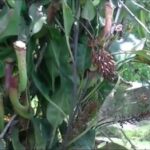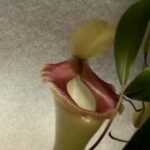As an Amazon Associate, this site earns commissions from qualifying purchases. For more details, click here.
Found in many parts of the Philippines, nepenthes alata is known for its colorful leaves and large pitchers. It is a beautiful carnivorous plant and also happens to be one of the easiest to grow. If you want to add something unique to your collection, n. alata is a good choice. If you follow this guide you will see how simple it is to raise.
Nepenthes alata grows best hanging from a basket in indirect light. Use porous, low nutrition soil and keep this plant in 53-85 F temperature. Nepenthes alata does not need dormancy and prefers at least 60% humidity.
Nepenthes Alata Care Sheet
| Soil | 1:1 peat moss and perlite, moist soil needed |
| Water | Spring water, purified, reverse osmosis, distilled |
| Light | 6-8 hours bright indirect light |
| Food | Freeze dried worms, fish pellets, small bugs |
| Temperature | 53-85 F (12-30 C) |
| Humidity | 60% |
| Dormancy | No |
| Propagation | Stem cutting |
Soil
Nepenthes alata only grows in poor soil such as live sphagnum moss. The typical nepenthes soil mix consisting of perlite and peat moss works as well. You can also try silica sand and peat. The typical ratio is 1:1 for the potting media.
Just like other tropical pitcher plants, the soil must always be moist. Do not fertilize it, do not add compost or any material that could enrich it. Any potting soil for regular houseplants should never be used with nepenthes alata.
These plants are usually shipped with sphagnum moss so no need to buy the soil separately. If you have experience growing nepenthes and want to try peat or other media, feel free to do so. Once your soil is set, take care not to get any food into the soil when feeding the plant.
Pot Container
Nepenthes alata can produce 6 to 8 inch pitchers and needs space for its leaves as well. They are usually sold in hanging baskets.
Some n. alata are sold bare root with only the soil included. Other vendors sell growing nepenthes in containers so the choice is up to you.
If you want to add n. alata to your collection now, buying a growing plant is the way to go. You do not have to prepare any soil and you do not have to wait for the pitchers to appear.
All you have to do is hang the plant and you are done. For more about hanging pitcher plants you may check this post. Note that you can grow n. alata on a typical pot, but make sure there is plenty of space as its leaves can spread.
Water
Water nepenthes alata until the soil is moist but too damp. Do not sit the plant in water. While some tropical pitcher plants do well with the tray method, n. alata tolerates heat better than water.
Water nepenthes alata from the top. Use only purified, distilled or spring water. If you can collect enough rain water that would be great too. Based on our experience, Bay Bay Water works well too.
Use only as much water as is needed to moisten the soil. Repeat when the soil starts drying. You may have to do this 1-2 times a day depending on the season. Some pitcher plants adopt to the tray method well, but mostly you should avoid it. Nepenthes alata are usually hung from baskets anyway so it not practical. If watering from the top keeps the soil moist and your plant looks fine, stick with it.
Too much water can cause a lot of problems such as root rot. Overwatered roots turn into mush and the plant begins to smell and decay. Too little water and its leaves will dry up and the pitchers will run out of liquids.
If your nepenthes looks dehydrated and its pitchers empty, increase the humidity or water more frequently. If you really want to try the tray method, pour only an inch of water.
Light
Nepenthes alata requires bright light, but it must be indirect. Whether the plant is on a windowsill or hanging outdoors, it must be partially shaded and never directly under the sun.
If your n. alata is on a hanging basket, ensure it gets light but is not too hot. Pitcher plants need more light than heat. While nepenthes alata can handle more heat compared to other species, you should avoid prolonged exposure.
Keeping your pitcher plants in partial light is not hard. All you have to do is find a suitable place to hang the basket (or baskets). If you find a sunny spot where the sun does not directly shine on, perfect.
If your nepenthes alata is on a regular pot, set it on a windowsill. That will provide the right balance of light and shade.
Nepenthes alata also grows with indoor plant lights. You will find these handy during winter when natural light is limited. Our preferred choice is Barrina Plant Grow Light because it provides the ind of lighting n. alata needs.
Temperature
The ideal temperature for nepenthes alata is 53-85 F (12-30 C). These tropical pitcher plants are known to live in hotter temperatures up to 90 degrees or more, albeit for brief periods. If it is 90 F and above, put the plant under partial shade.
For the best results you should try to keep the plant at 85 degrees and below. But if the weather occasionally reaches into the 90s it will not harm the plant.
Cold is far more risky for n. alata. These plants cannot survive winter frost so you have to keep the temperature at 53 F and higher. While the plant will live in mid 50s, something higher is better.
Nepenthes alata tolerates heat well. If you live in USDA zone 10 or higher you can leave n. alata outdoors permanently.
Humidity
Nepenthes alata will do fine in medium to high humidity. The minimum rate should be 60% though some variants can thrive in 50% levels.
Because n. alata needs sunlight like n. albormaginata and the right temperature, its humidity requirement is sometimes overlooked. But if you can get the temperature range right, it will be easier to control .
Nepenthes alata requires bright light and warm conditions to thrive. Too much heat and warmth leads to dryness though, so that is where humidity comes in. At 60% or higher, this provides the plant with the resources necessary to produce liquid for its pitchers.
If humidity is too low you can use a humidifier. This will come in handy during summer when it gets really hot and the atmosphere is dry. While 60% is the minimum rate, consider increasing it to 80% or higher if the plant is struggling.
Nutrition and Feeding
Feeding nepenthes alata is very easy. The plant eats yellow jackets, grasshoppers, spiders, flies, ants etc. You can also give it any freeze dried bug, mealworms or fish food.
If your nepenthes alata is outdoors, check its pitchers first. If they contain trapped bugs, the plant is already getting enough nutrients and you do not need to provide anymore.
If you have live or dead insects at hand, just drop a few into its pitchers. Better yet just give it some mealworms or crushed fish food. You do not have to feed each pitcher, even a couple will be enough. Do this only if your plant is not eating enough.
You may add a few drops of water into the food before dropping them into the pitcher. This will help the plant digest the material. But if its pitchers already have liquids this might not be necessary.
Once you drop the food into the pitcher the plant will take care of the rest. It might take some time for the plant to digest but it will. Keep in mind that pitcher plants do not need a lot of nutrients especially if they are getting plenty of light.
Dormancy
Like other tropical pitcher plants, nepenthes alata does not go through a dormant phase. It cannot live through below freezing cold so you have to protect it during winter.
As pointed out earlier, nepenthes alata prefers warm conditions and high humidity. If you live in a cold region, it will be difficult to grow this plant, at least outdoors. The best option is to raise nepenthes indoors somewhere warm – you will need a heat source –and keep it there.
If you have warm summers and cold winters, you can hang the plant outdoors. As long as it is around 60-85 F outdoors n. alata should be fine. But you have to bring the plant inside on the temperature starts to drop.

My fascination with carnivorous plants began many, many years ago with Venus Fly Traps. Now I am more than happy to impart what I know with other enthusiasts and those who are curious about meat eating plants.



